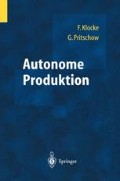Abstract
The pioneering scalar chatter stability models were introduced by (1957), and (1958) almost at the same period but independent of each other. Tlusty proposed the following chatter stability expression:
where a lim is the critical depth of cut without chatter, K s[N/m 2] is the cutting coefficient representing the hardness of the material and the tool geometry influence, and G o[m/N] is the negative real part of the frequency response function of the structure oriented in the direction of chip thickness. Tobias’s (Tobias and Fiswick 1958; Tobias 1965) model is similar except that he considered the cutting coefficient as a complex number with dependency on effective cutting speed and chip thickness. Tobias also introduced the stability lobes (Tobias and Fiswick 1958) which show the stable spindle speed and depth of cut combinations using the phase relationship between the vibration waves left on the cut surface and natural modes of the structure. The basic chatter theory presented by Tlusty and lobes introduced by Tobias had a fundamental impact in guiding the design of machine tools and the selection of productive cutting conditions. Although the theory was based on orthogonal cutting conditions, where the machining system is continuous without time varying dynamics, researchers and engineers used it with great success by simple adjustments based on intuitions and experience. (Merritt 1965) reformulated the orthogonal chatter theory based on Nyquist’s Stability law. Tlusty (Koenigsberger and Tlusty 1967) introduced orientation of the cutting forces, average number of teeth in cut and flexibilities in the direction of chip which allowed application of the staler chatter theory to practical turning, milling and shaping operations.
Access this chapter
Tax calculation will be finalised at checkout
Purchases are for personal use only
Preview
Unable to display preview. Download preview PDF.
References
Altintas Y, Budak E (1995) Analytical Prediction of Stability Lobes in Milling, Annals of CIRP, Vol. 44/1, pp. 357–362, 1995
Altintas Y, Lee P (1998) Mechanics and Dynamics of Ball End Milling Transactions of ASME, Journal Manufacturing Science and Engineering, vo1.120, pp. 684–692
Altintas Y, Shamoto E, Lee P, Budak E (1999) Analytical Prediction of Stability Lobes in Ball End Milling, Transactions of ASME Journal of Manufacturing Science, Transactions of ASME Journal of Manufacturing Science and Engineering, vo1. 121, pp. 586–592
Altintas Y, Engin S, Budak E (1999) Analytical Prediction of Chatter Stability and Design for Variable Pitch Cutters, Trans. ASME, Manufacturing and Engineering and Science, vol. 121, pp. 173–178
Altintas Y (2001) Analytical Prediction of Three Dimensional Chatter Stability in Milling, Japan Society of Mechanical Engineers, International Vol. 44/3, pp. 717–723
Altintas Y (2000) Manufacturing Automation: Principles of Metal Cutting and Machine Tool Vibrations, Cambridge University Press
Altintas Y, Engin S (2001) Generalized Modeling of Mechanics and Dynamics of Milling Cutters, CIRP Annals, vol. 50/1, pp. 25–30
Budak E, Altintas Y (1998) Analytical Prediction of Chatter Stability Conditions for Multi-Degree of Systems in Milling. Part I: Modeling, Transactions of ASME, Journal of Dynamic Systems, Measurement and Control, vol. 120, pp. 22–30
Budak E, Altintas Y (1998) Analytical Prediction of Chatter Stability Conditions for Multi-Degree of Systems in Milling. Part II: Applications, Transactions of ASME, Journal of Dynamic Systems, Measurement and Control, vol. 120, pp. 31–36
CUTPRO (2000) Advanced Milling Process Simulation System, Time Domain Simulations Module, University of British Columbia
Davies M, Pratt JR, Dutterer, Burns TJ (2002) Stability Prediction for Low Radial Immersion Milling, Trans. ASME, J. Manufacturing Science and Engineering, Vol. 124, pp. 217–225
Jensen SA, Shin YC (1999) Stability Analysis in Face Milling Operations, Trans. ASME, J. Manuf. Sc. and Eng., vol. 121, pp. 600–605
Koenigsberger F, Tlusty J (1967) Machine Tool Structures-Vol.I: Stability Against Chatter, Pergamon Press
Merritt HE (1965) Theory of Self-Excited Machine Tool Chatter Trans. ASME Journal of Engineering for Industry, 87:447–454
Minis I, Yanushevsky T (1993) A New Theoretical Approach for the Prediction of Machine Tool Chatter in Milling, Trans. ASME Journal of Engineering for Industry, 115:1–8
Montgomery D, Altintas Y (1991) Mechanism of Cutting Force and Surface Generation in Dynamic Milling, Trans. ASME Journal of Engineering for Industry, vol 113:160–168
Opitz H, (1969) Investigation and Calculation of the Chatter Behavior of Lathes and Milling Machines, Annals of the CIRP, vol. 18, pp. 335–342
Smith S, Tlusty J (1993) Efficient Simulation Programs for Chatter in Milling, Annals of the CIRP, 42/1:463–466
Sridhar R, Hohn RE, Long GW (1968) A Stability Algorithm for the General Milling Process, Trans. ASME Journal of Engineering for Industry, vol. 90, pp. 330–334
Tlusty J (2000) Personal Communications, September 1999–May 2000, Machine Tool Research Center, University of Florida, Gainesville.
Tlusty J, Ismail F, (1981) Basic Nonlinearity in Machining Chatter, Annals of the CIRP, 30:21–25
Tlusty J (1986) Dynamics of High Speed Milling, Trans. ASME, J. Eng. Industry, vol. 108, pp. 59–67
Tlusty J, Polacek M, (1957) Besipiele der behandlung der selbsterregten Schwingung der Werkzeugmaschinen, FoKoMa, Hauser Verlag, Munchen.
Tobias SA, Fiswick W (1958), Theory of Regenerative Machine Tool Chatter, Engineering, London, vol. 258
Tobias SA, (1965) Machine Tool Vibrations. Blackie and Sons Ltd.
Weck M, Altintas Y, Beer C (1994) CAD Assisted Chatter Free NC Tool Path Generation in Milling, International Journal of Machine Tool Design and Research, 34(6):879–891
Weck M (2002) Werkzeugmaschinen — Fertigungssysteme 2 Konstruktion and Berechnung, VDI-Verlag GmbH, Düsseldorf
Weck M, Teipel K (1977) Dynamisches Verhalten spanender Werkzeugmaschinen: Einflussgroben, Beurteilungsverfahren, Messtechnik, Berlin, Heidelberg, New York, Springer
Editor information
Editors and Affiliations
Rights and permissions
Copyright information
© 2004 Springer-Verlag Berlin Heidelberg
About this chapter
Cite this chapter
Altintas, Y. (2004). Critical Review of Chatter Vibration Models for Milling. In: Klocke, F., Pritschow, G. (eds) Autonome Produktion. Springer, Berlin, Heidelberg. https://doi.org/10.1007/978-3-642-18523-6_4
Download citation
DOI: https://doi.org/10.1007/978-3-642-18523-6_4
Publisher Name: Springer, Berlin, Heidelberg
Print ISBN: 978-3-642-62143-7
Online ISBN: 978-3-642-18523-6
eBook Packages: Springer Book Archive

